#migration strategy
Explore tagged Tumblr posts
Text
#migrants#poland#finland#migration strategy#polish prime minister donald tusk#temporary suspension of migrants' right to asylum#asylum seekers
2 notes
·
View notes
Text
#Australia#migrant intake#tougher tests#Indian students#population increase#Australian Bureau of Statistics#migration strategy#English-language test#genuine students#skills shortages#overseas students#second course#second student visa#immigration policy#Pramod Thomas#Clare O’Neil#home affairs minister#Parliament House#Canberra#jobs and skills summit#Martin Ollman#Getty Images#immigration news#Australian government#international students#student visa#English proficiency#skills assessment#immigration reforms#Australian demographics
0 notes
Text
IS4 BN15 Ending 1 done with no progression tree. This certainly isn't the hardest thing I've done, but it is probably is the most stupid.





#arknights#is4#integrated strategies#afaik only 1 person (on CN) has done this so i believe i'm the 2nd person to have done this :D#shoutouts to my oomfie the surprise foldartal#probably about on par with the migrate foldartal that shit is so incredibly fucking busted
18 notes
·
View notes
Text
When Brian Eno wrote “Taking Tiger Mountain by Strategy” this is the mountain of tiger he was talking about

#brian eno#taking tiger mountain by strategy#art rock#lin hu#nekojishi#migrating my best tweets to tumblr so nothing ties me to twitter anymore and i can delete that account in peace#tiger#furrymemes
9 notes
·
View notes
Text
#AWS to Azure Migration#Cloud Migration Strategies#Azure Migration Tools#Cloud Computing#DevOps#Cloud Cost Optimization
0 notes
Text
The Windows 10 EOL Dilemma: Upgrade or Migrate?
🔹 Windows 10 EOL is coming. Windows 11 is the last x64-supported OS before Microsoft moves to ARM. Why buy new hardware when Linux keeps your current machine alive? 💻🐧 #Windows10EOL #LinuxMigration #TechStrategy #Microsoft #Linux #IT #Engineering
As a Principal Systems Architect, I don’t just follow trends. I analyze their long-term impact. And with Windows 10 hitting End-of-Life (EOL) on October 14, 2025, Microsoft is nudging users toward Windows 11, which will be the last version to support x64 processors before Microsoft fully embraces ARM architecture—just like Apple did with its M1 chips. For businesses and individuals reliant on x64…
#Future of Computing#IT Strategy#Linux Migration#Microsoft ARM Transition#Open-Source Computing#System Architecture#Windows 10 EOL#Windows 11
0 notes
Text
Accelerating Digital Transformation with Cloud Migration and Integrated IT systems
Smarter Integration can be deployed within any business or organization across all industries and sectors to provide a hybrid integration connectivity-as-a-service solution. It can be implemented agilely iteratively, as organizations do not need upfront infrastructure, software, or resource skills to get started.
Cloud Migration
From planning and designing a cloud migration strategy to accelerating the process and optimizing for ongoing performance, Smarter Integration helps ensure and measure the success of your cloud migration projects. The Smarter Integration platform helps engineering teams understand existing infrastructure and application architecture to ensure an effective and cost-efficient cloud migration strategy.
1. Leverage insights to assess which cloud-native technologies, such as Kubernetes or serverless functions, are best suited to your needs.
2. Map dependencies, patterns, and usage with Smartscape before refactoring applications.
3. Make informed decisions about architecting microservices and prioritizing workload migration.
Integrated IT systems
An integrated IT system is a system that combines different software and hardware modules into a single infrastructure. The goal is to make the systems work smoothly and share information and processes more efficiently. In an IT context, Integration refers to the result of a process that aims to combine different -- often disparate -- subsystems so that the data contained in each becomes part of a larger, more comprehensive system that, ideally, quickly and easily shares data when needed.
An Integrated Information System refers to a system that combines various databases, web-based information retrieval systems, and bibliographic and full-text systems to provide efficient control and access to different types of information formats and library collections.
Digital Transformation Strategy
Businesses are under greater pressure than ever to provide the best possible digital experience—not just for their customers but also for their staff and partners. However, many IT departments are still concerned with maintaining legacy systems, and senior management often does not understand what digital transformation strategy in the retail sector involves.
This creates the need for closer Integration between IT departments and business units. To deliver what the customer wants, businesses are increasingly turning to self-service solutions, allowing business units to build and maintain their own applications.
Discover a related blog here:
https://shorturl.at/ESrPl
https://shorturl.at/YJkyE
0 notes
Text
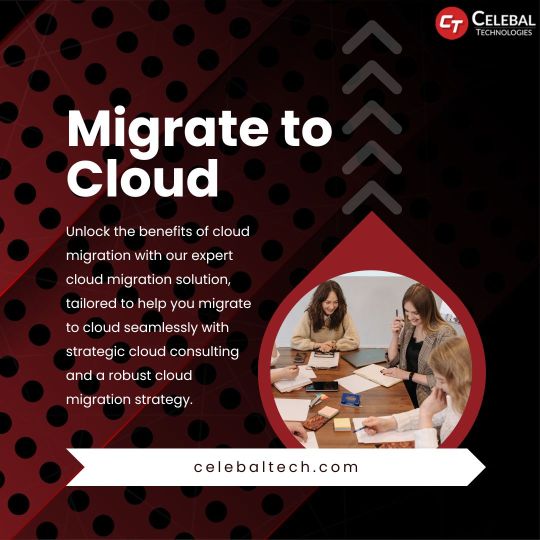
Contact Migrate to Cloud - Easy Cloud Migration Solution
#migrate to cloud#cloud migration solution#cloud consulting#cloud migration strategy#benefits of cloud migration
0 notes
Text
AWS Cloud Migration: Benefits, Strategies, and Phases Simplified

Many businesses embark on their cloud migration journey with a strategy known as “lift and shift.” This approach involves relocating existing applications from on-premises environments to the cloud without altering their architecture. It’s an efficient and straightforward starting point, often appealing due to its simplicity and speed.
However, as companies dive deeper into the cloud ecosystem, they uncover a broader spectrum of possibilities. Lift and shift, though effective initially, is only the foundation of cloud migration. Businesses quickly realize that cloud computing offers far more than just infrastructure relocation.
To unlock its true potential, modernization becomes essential. Modernization transforms applications to align with cloud-native architectures. This ensures businesses can harness advanced features like scalability, resilience, and cost efficiency. It’s no longer about merely shifting workloads; it’s about reimagining them for the future.
This evolution in approach is also reflected in the market’s staggering growth. According to Gartner, Inc., global end-user spending on public cloud services is projected to grow by 20.4% in 2024, reaching $675.4 billion from $561 billion in 2023. Generative AI (GenAI) and application modernization are major drivers of this surge. This data underscores the strategic importance of not just migrating to the cloud but modernizing applications to stay competitive in an evolving landscape.
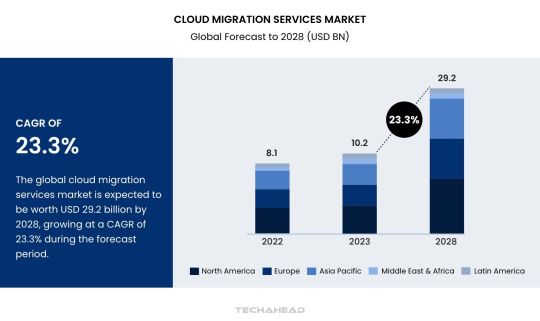
For instance, early adopters of cloud migration often struggled with limited performance gains post-migration. They soon discovered that while lift and shift addressed immediate needs, it didn’t optimize long-term efficiency. Modernization solved this challenge by enabling applications to utilize the dynamic capabilities of cloud platforms.
This shift in approach isn’t just about technology—it’s about competitiveness. Businesses that embrace modernization gain agility and faster time-to-market, giving them a significant edge. They leverage tools like containerization and serverless computing, allowing seamless adaptation to evolving customer demands.
In this blog, we’ll delve into the reasons why lift and shift is just the starting line. We’ll also explore how modernization drives real value and share best practices for ensuring a smooth transition. By the end, you’ll understand why adapting to the evolving cloud landscape is not just a choice—it’s a necessity.
Benefits of AWS Migration
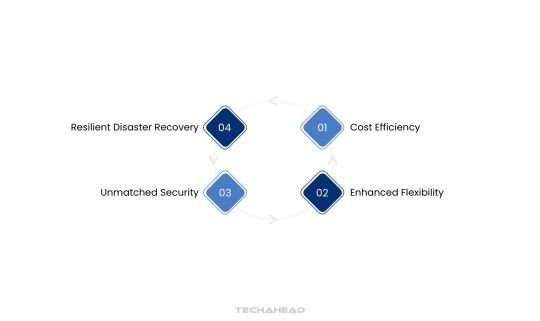
Transitioning your cloud infrastructure to the AWS cloud unlocks unparalleled scalability and efficiency. AWS provides a suite of advanced computing resources tailored to manage IT operations seamlessly. This enables your business to channel its efforts, resources, and investments into core activities that drive growth and profitability.
By adopting AWS cloud infrastructure, you eliminate the constraints of physical data centers and gain unrestricted, anytime-anywhere access to your data. Global giants like Netflix, Facebook and the BBC leverage AWS for its unmatched reliability and innovation. Let’s explore how AWS helps streamline IT operations while ensuring cost-effectiveness and agility.
Cost Efficiency
Expanding cloud infrastructure typically requires significant investment in hardware and administrative overhead. AWS eliminates these costs with a pay-as-you-go model.
Zero Upfront Investment: Run enterprise applications and systems without the need for large initial capital.
Flexible Scaling: AWS enables businesses to upscale or downscale resources instantly, ensuring that you never pay for unused capacity. This dynamic scaling matches your operational demands and avoids the waste associated with overprovisioning.
Advanced Cost Control: AWS provides tools like Cost Explorer and AWS Budgets, helping businesses track, forecast, and optimize cloud expenses. By analyzing consumption patterns, organizations can minimize waste and ensure maximum return on investment (ROI).
Reduced Maintenance Overheads: Without the need to maintain physical servers, businesses save on administrative and repair costs, redirecting budgets to strategic growth areas.
Enhanced Flexibility
AWS offers unparalleled adaptability, making it suitable for businesses of all sizes, whether they are start-ups, enterprises, or global businesses. Its integration capabilities enable smooth migrations and rapid scaling.
Seamless Compatibility: AWS supports a vast number of programming languages, operating systems, and database types. This ensures that existing applications or software frameworks can integrate effortlessly, eliminating time-consuming reconfigurations.
Rapid Provisioning of Resources: Whether migrating applications, launching new services, or preparing for DevOps, AWS provides the agility to provision resources instantly. For instance, during seasonal demand spikes, businesses can quickly allocate additional capacity and scale back during off-peak times.
Developer Productivity: Developers save time as they don’t need to rewrite codebases or adopt new frameworks. This allows them to focus on building innovative applications rather than troubleshooting compatibility issues.
Unmatched Security
Security is a cornerstone of AWS’s offerings, ensuring that your data remains protected against internal and external threats. AWS combines global infrastructure standards with customizable tools to meet unique security needs.
Shared Responsibility Model: AWS takes care of the underlying infrastructure, including physical security and global compliance. Customers are responsible for managing access, configuring permissions, and securing their data.
Data Encryption: AWS allows businesses to encrypt data both at rest and in transit, ensuring end-to-end protection. Businesses can leverage services like AWS Key Management Service (KMS) for robust encryption.
Compliance and Governance: AWS adheres to internationally recognized standards, including ISO 27001, GDPR, and SOC. This helps businesses meet legal and regulatory requirements with ease.
Threat Mitigation: AWS offers tools like AWS Shield and GuardDuty to detect and mitigate cybersecurity threats in real time, providing peace of mind in a rapidly evolving threat landscape.
Resilient Disaster Recovery
Disruption like power outages, data corruption, or natural disasters can cripple traditional IT systems. AWS AWS equips businesses with robust disaster recovery solutions to maintain operational continuity.
Automated Recovery Processes: AWS simplified disaster recovery through services like AWS Elastic Disaster Recovery, which automates recovery workflows and reduces downtime significantly.
Global Redundancy: Data is stored across multiple geographic locations, ensuring that even if one region experiences issues, operations can seamlessly shift to another. This minimizes disruptions and maintains business continuity.
Cost-Efficient Solutions: Unlike traditional disaster recovery setups that duplicate hardware, AWS’s cloud-based approach uses on-demand resources. This reduces capital investments while delivering the same level of protection.
Faster Recovery Times: With AWS, businesses can restore systems and data within minutes, ensuring minimal impact on operations and customer experiences.
Cloud migration with AWS is more than just a technological upgrade; it’s a strategic move that empowers businesses to innovate, scale, and thrive in a competitive market. By leveraging AWS, organizations can reduce costs, enhance flexibility, strengthen security, and ensure resilience.
7 Cloud Migration Strategies for AWS
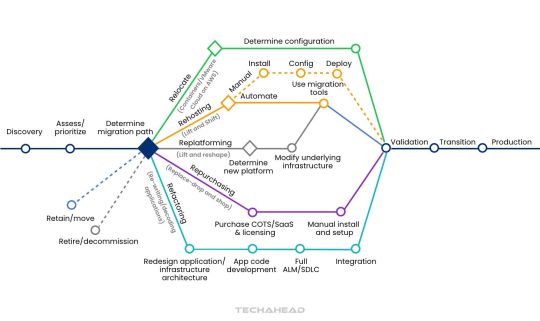
AWS’s updated 7 Rs model for cloud migration builds on Gartner’s original 5 Rs framework. Each strategy caters to unique workloads and business needs, offering a tailored approach for moving to the cloud. Let’s explore these strategies in detail.
Rehost (Lift and Shift)
The rehost strategy involves moving workloads to the cloud with minimal changes using Infrastructure-as-a-Service (IaaS). Enterprises migrate applications and dependencies as they are, retaining the existing configurations. This approach ensures operational consistency and reduces downtime during migration. It is an easy-to-perform option, especially for businesses with limited in-house cloud expertise. Additionally, rehosting helps businesses avoid extensive re-architecting, making it a cost-effective and efficient solution.
Relocate (Hypervision-Level Lift and Shift)
Relocating shifts workloads to a cloud-based platform without altering source code or disrupting ongoing operations. Organizations can transition from on-premises platforms like VMware to cloud services such as Amazon Elastic Kubernetes Service (EKS). This strategy minimizes downtime and ensures seamless business operations during migration. Relocating maintains existing configurations, eliminating the need for staff retraining or new hardware. It also offers predictable migration costs, with clear scalability limits to control expenses.
Replatform (Lift and Reshape)
The replatform approach optimizes workloads by introducing cloud-native features while maintaining the core application architecture. Applications are modernized to leverage automation, scalability, and cloud compliance without rewriting the source code. This strategy enhances resilience and flexibility while preserving legacy functionality. Partial modernization reduces migration costs and time while ensuring minimal disruptions. Teams can manage re-platformed workloads with ease since the fundamental application structure remains intact.
Refactor (Re-architect)
Refactoring involves redesigning workloads from scratch to utilize cloud-native technologies and features fully. This strategy supports advanced capabilities like serverless computing, autoscaling, and enhanced automation.
Refactored workloads are highly scalable and can adapt to changing demands efficiently. Applications are often broken into microservices, improving availability and operational efficiency. Although refactoring requires significant initial investment, it reduces long-term operational costs by optimizing the cloud framework.
Repurchase (Drop and Shop)
Repurchasing replaces existing systems with third-party solutions available on the cloud marketplace. Organizations adopt a Software-as-a-Service (SaaS) model, eliminating the need for infrastructure management. This approach reduces operational efforts and simplifies regulatory compliance, ensuring efficient governance. Repurchasing aligns IT costs with revenue through consumption-based pricing models. It also accelerates migration timelines, enhancing user experience and performance with minimal downtime.
Retire
The retirement strategy focuses on decommissioning applications that no longer hold business value. Inefficient legacy systems are terminated or downsized to free up resources for more critical functions. Retiring outdated workloads reduces operational costs and simplifies IT management. This strategy also allows businesses to streamline their application portfolio, focusing efforts on modernizing essential systems.
Retain (Revisit)
The retain strategy is used for applications that cannot yet be migrated to the cloud. Some workloads rely on systems that need to be transitioned first, making retention a temporary solution. Businesses may also retain applications while waiting for SaaS versions from third-party providers. Retaining workloads provides flexibility, allowing organizations to revisit migration strategies and align them with long-term objectives.
Cloud Transformation Phases
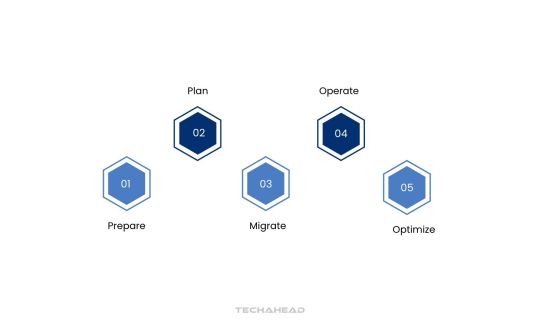
Cloud transformation is a comprehensive process where businesses transition from traditional IT infrastructure to a modern, cloud-centric framework. Below is an in-depth exploration of its critical phases.
Prepare
The preparation phase sets the foundation for a successful migration by assessing feasibility and identity benefits.
Evaluate current IT infrastructure: Audit existing hardware, software, and networks to confirm if the cloud aligns with organizational goals. This step ensures clarity about readiness.
Identify potential risks: Analyze risks like data loss, downtime, or security threats. A detailed mitigation strategy ensures minimized disruptions.
Analyze interdependencies: Understand how applications, databases, and systems interact to prevent issues during migration. Dependency mapping is vital for seamless transitions.
Select a migration strategy: Choose from approaches such as rehosting, refactoring, or rebuilding. Tailor the strategy to meet specific organizational needs and ensure efficiency.
Plan
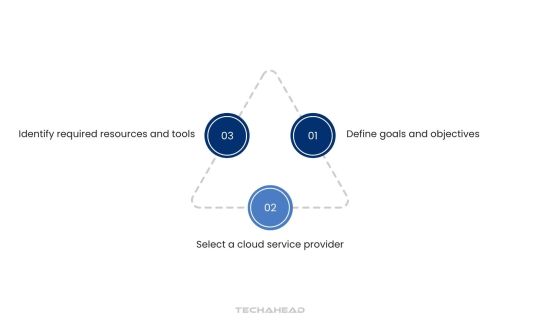
The planning phase involves creating a structured roadmap for the migration process, ensuring alignment with business objectives.
Define goals and objectives: Establish specific goals like cost reduction, scalability improvement, or enhanced security. This clarity drives project focus.
Select a cloud service provider: Choose a provider that matches your organization’s priorities. Evaluate cost, performance, security, and customer support before finalizing.
Identify required resources and tools: Determine essential resources such as migration tools, management software development, and skilled personnel to execute the project effectively.
Migrate
Migration focuses on the actual transfer of IT infrastructure, applications, and data to the cloud.
Configure and deploy cloud resources: Set up virtual machines, storage, and networking components to create a robust cloud environment for workloads.
Migrate data securely: Use data migration tools or replication techniques to ensure secure and accurate data transfer with minimal disruptions.
Test applications in the cloud: Run performance tests to verify that applications meet operational requirements. Address issues before full-scale deployment.
Operate
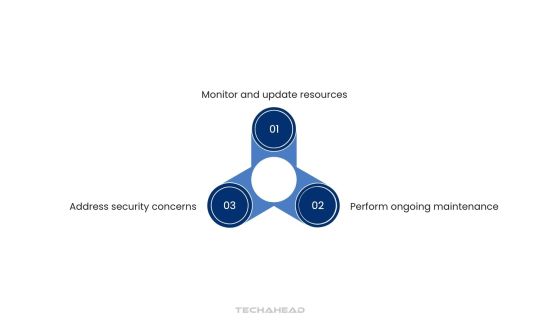
The operation phase emphasizes managing and maintaining the cloud environment for optimal performance.
Monitor and update resources: Continuously monitor cloud infrastructure to identify bottlenecks and ensure resources align with evolving organizational needs.
Perform ongoing maintenance: Proactively resolve infrastructure or application issues to prevent service interruptions and maintain system integrity.
Address security concerns: Implement robust security measures, including encryption, access controls, and regular log reviews, to safeguard data and applications.
Optimize
Optimization ensures that cloud resources are fine-tuned for maximum performance and cost efficiency.
Monitor performance metrics: Use advanced monitoring tools to track application performance and identify improvement opportunities in real time.
Adjust and fine-tune resources: Scale resources dynamically based on demand to maintain performance without unnecessary cost overheads.
Leverage cost-saving features: Use provider offerings like auto-scaling, reserved instances, and spot instances to minimize operational costs while maintaining quality.
By thoroughly understanding and executing each phase of cloud transformation, organizations can achieve a seamless transition to a modern, efficient cloud environment. This structured approach ensures scalability, performance, and long-term success.
Conclusion
Cloud migration is a multifaceted process that demands in-depth analysis of existing challenges and aligning them with strategic changes to meet business objectives. Selecting the right migration strategy depends on workload complexities, associated costs, and potential disruption to current systems. Each organization must evaluate these factors to ensure a smooth transition while minimizing impact.
While the benefits of a well-planned migration are significant, organizations must address the ongoing risks and effort required for maintenance. Ensuring compatibility and performance in the cloud environment demands continuous oversight and optimization.
For a deeper understanding of how TechAhead can streamline your cloud migration journey, explore our comprehensive guide on migrating enterprise workloads. Our cloud migration case studies also provide insights into the transformative advantages of moving critical business operations to the cloud. Partnering with experts ensures a seamless transition, unlocking agility, scalability, and innovation for your business.
Source URL: https://www.techaheadcorp.com/blog/aws-cloud-migration-benefits-strategies-and-phases-simplified/
#AWS Cloud Services#Cloud Transformation#AWS Cloud Migration#Lift and Shift Cloud Migration#Cloud Migration Strategies
0 notes
Text

Not all cloud migration strategies are the same! Explore the options to find the perfect fit for your CCaaS migration needs. #CloudMigration #CCaaS
0 notes
Text
This playbook will provide you with best practices, tools, and strategies for migrating to Python 3 and case studies from companies such as Dropbox, Reddit, and Instagram, as well as words of wisdom from industry experts.
0 notes
Text
#poland#asylum seekers#temporary suspension of the right to asylum#illegal migration#migration strategy#polish prime minister donald tusk#civic coalition party
0 notes
Text
Discover a step-by-step guide to cloud migration in 2025, covering various types and best practices to ensure a smooth and efficient cloud transition for businesses.
#cloud migration types#cloud migration best practices 2025#steps in cloud migration#cloud transformation guide#future cloud strategies.
0 notes
Text
Brownfield vs. Greenfield: Unlocking the Best SAP S/4HANA Migration Strategy
Discover the differences between Greenfield and Brownfield migration approaches to SAP S/4HANA and choose the best strategy for a seamless transition.
#SAP S/4HANA Migration#Brownfield Approach#Greenfield Approach#SAP Migration Strategies#SAP S/4HANA Transformation#Brownfield vs Greenfield#SAP ERP Migration#SAP Implementation Tips#S/4HANA Upgrade#SAP Migration Best Practices
0 notes
Text
Cloud-Migration: Optimierung der IT-Infrastruktur Schritt für Schritt
Die Cloud-Technologie hat das Potenzial, die Art und Weise, wie Unternehmen ihre IT-Infrastruktur betreiben, grundlegend zu verändern. Cloud-Migration ermöglicht es Unternehmen, ihre Ressourcen flexibler, skalierbarer und kosteneffizienter zu nutzen. Dennoch ist der Übergang zur Cloud kein einfacher Prozess und erfordert eine sorgfältige Planung und Strategie. In diesem Artikel werden wir…
#Automatisierung#Automatisierungstools#Best Practice#Best Practices#Cloud-Migration#Cloud-Services#Cloud-Strategie#Datenverschlüsselung#Innovation#IT-Infrastruktur#Sicherheitsrichtlinien#Sicherheitsrisiken#Sicherheitsstrategie#Sicherheitsüberprüfungen#Transparenz#Unternehmensziele#Verschlüsselung
0 notes
Link
If you’re a business owner in regional Australia, you’ve probably felt the challenge of finding the skilled workers you need to keep things running smoothly. This guide is here to make things easier. We’ll answer the big questions on your mind
0 notes